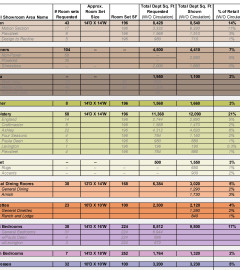
Last year my team at Martin Roberts Design re‐planned and re‐merchandised more than one million square feet of retail space in 30 or so stores around the country. As a retail designer, I’ve helped hundreds of store owners rethink their showrooms.
When merchants ask me to revitalize their space, they frequently say it’s because it’s not living up to its sales potential. They’re convinced that if they can learn the secrets to laying out their showroom more effectively, profits will soar.
Published first in Patio & Hearth.
I don’t dispute that the showroom layout is vitally important. But before you can configure your space, maximizing sales requires looking at the categories of product you currently sell and figuring out what percentage of sales come from each category. Why? Because the amount of merchandise you display must correspond to the percentage of business you do in each category.
In other words, if you have a 100,000‐square‐foot store, and 55 percent of your business is in upholstery, you’ll dedicate 55,000 square feet of retail space to upholstery.
The Merchandising Matrix
I’ve created a simple tool called a Merchandising Matrix that enables store owners to figure out how much square footage they currently devote to each product category. It’s not as complicated as you might think.
First determine the room set size you use for a category, then multiply it by the number of room sets you display. So for example, if you currently use a 10‘ x 15’ room set size for stationary upholstery, and you have 28 room sets, that department takes up 4,600 square feet of floor space, excluding main access aisles.
Once you’ve calculated square footage for each department, the next step is to analyze your sales figures. By determining the percentage of sales that come from stationary upholstery, for instance, you’ll be able to compare the amount of space you now allot to that department versus the percentage that should be allotted. You may discover that you have too much or not enough stationary upholstery in your product mix and that you’ll need to make adjustments. But you’ll also discover that in some cases you were fairly accurate in estimating the amount of merchandise for a given category.
One of my clients, an owner of a well regarded furniture store, adopted the Merchandising Matrix, only to be surprised by the results. He realized that some of his guesstimates for how much product he should purchase were way off the mark. In one instance, he thought he needed five or six sets in a department, only to discover that he really needed three and he already had two in the warehouse. In the first month after we redesigned his store, his sales increased by 94 percent, a fair amount of which can be attributed to the new merchandising process.
The Merchandising Matrix chart allows us to give pride of place to products that are doing the lion’s share of the business. I am not exaggerating when I say that this method will radically improve your bottom line, enabling you to achieve higher dollars‐per‐square‐foot.
Purchasing Pitfalls
Throughout my career as a retail designer, I’ve observed that too many merchants, like cowboys in the Old West, shoot from the hip when making purchases for their store. Being strategic and disciplined in displaying the right amount of product per department goes hand in hand with purchasing.
Most retailers start with the best of intentions, shopping list in hand, when market rolls around. Unfortunately, there are so many ways to lose sight of the original plan and start buying emotionally. It’s all too easy to get caught up in the excitement of market and to make spur‐of‐the‐moment purchases. Or you decide to take advantage of a hot market special, or feel you owe a sales rep a generous order out of friendship.
But when you follow the Merchandising Matrix approach, you are more likely to make well‐thought‐out purchases, since you know in advance exactly how many items will fit in each category of your showroom layout.
How you use the most valuable asset you have as a retailer—your square footage—can be crucial to your success. You air‐condition it, heat it, light it, maintain it, and spend money on real estate, taxes and everything else. Why not adopt a strategy that helps you make the best and most profitable use of your investment?